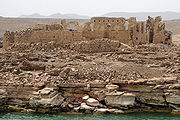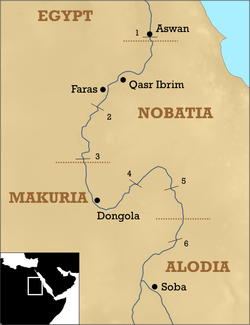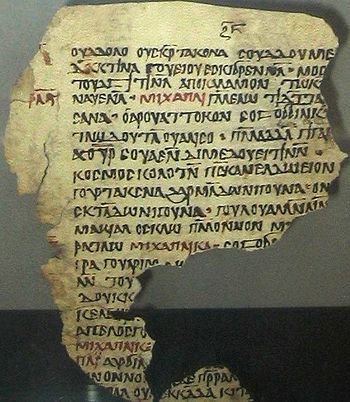
Qasr Ibrim
Encyclopedia

Archaeological site
An archaeological site is a place in which evidence of past activity is preserved , and which has been, or may be, investigated using the discipline of archaeology and represents a part of the archaeological record.Beyond this, the definition and geographical extent of a 'site' can vary widely,...
in Lower Nubia
Lower Nubia
Lower Nubia is the northern portion of Nubia, downstream on the Nile from Upper Nubia. It lies between the First and Second Cataracts, roughly from Aswan in the north to Wadi Halfa in the south. A great deal of Lower Nubia was flooded with the construction of the Aswan High Dam and the creation...
. It was originally a major city perched on a cliff above the Nile
Nile
The Nile is a major north-flowing river in North Africa, generally regarded as the longest river in the world. It is long. It runs through the ten countries of Sudan, South Sudan, Burundi, Rwanda, Democratic Republic of the Congo, Tanzania, Kenya, Ethiopia, Uganda and Egypt.The Nile has two major...
, but the flooding of Lake Nasser
Lake Nasser
Lake Nasser is a vast reservoir in southern Egypt, and northern Sudan, and is one of the largest man-made lakes in the world. Strictly, "Lake Nasser" refers only to the much larger portion of the lake that is in Egyptian territory , with the Sudanese preferring to call their smaller body of water...
after the construction of the Aswan High Dam transformed it into an island and flooded its outskirts. Qasr Ibrim is the only major archaeological site in Lower Nubia to have survived the Nile floods. Both prior to and after the Nile floods, it has remained a major site for archaeological investigations.
History


Late Period of Ancient Egypt
The Late Period of Ancient Egypt refers to the last flowering of native Egyptian rulers after the Third Intermediate Period from the 26th Saite Dynasty into Persian conquests and ended with the death of Alexander the Great...
, but it reached its greatest prominence in the Middle Ages
Middle Ages
The Middle Ages is a periodization of European history from the 5th century to the 15th century. The Middle Ages follows the fall of the Western Roman Empire in 476 and precedes the Early Modern Era. It is the middle period of a three-period division of Western history: Classic, Medieval and Modern...
, when the area was the home of the Eparch of Nobatia
Nobatia
Nobatia or Nobadia was an ancient African Christian kingdom in Lower Nubia and subsequently a region of the larger Nubian Kingdom of Makuria...
. Qasr Ibrim is the source of the largest collection of Old Nubian documents ever found, including the records of the Eparch. The site was inhabited until the 1840s. Today the island is closed to all but archaeologists.
This important site derives its name from the nearby village of Ibrim, on the east bank of the Nile. Wasr Ibrim is also notable for its fortress of Qasr Ibrim ("The Castle of Ibrim"), which certainly stood on older pharaonic foundations. Partly built "in Roman times under the prefecture of Gaius Petronius during Augustus' reign," it was originally a pharaonic site with material from the New Kingdom and later periods of Egyptian history being found here. This is established by reused and isolated monuments from this older period: the earliest record is a dated Year 8 stela of Amenhotep I
Amenhotep I
Amenhotep I was the second Pharaoh of the 18th dynasty of Egypt. His reign is generally dated from 1526 to 1506 BC. He was born to Ahmose I and Ahmose-Nefertari, but had at least two elder brothers, Ahmose-ankh and Ahmose Sapair, and was not expected to inherit the throne...
while "a temple structure of Taharqa
Taharqa
Taharqa was a pharaoh of the Ancient Egyptian 25th dynasty and king of the Kingdom of Kush, which was located in Northern Sudan.Taharqa was the son of Piye, the Nubian king of Napata who had first conquered Egypt. Taharqa was also the cousin and successor of Shebitku. The successful campaigns of...
(with a painting showing the king offering to a god)" is also known here. The stela was found in a now ruined Christian Byzantine cathedral now at Qasr Ibrim where it had been reused in one of the church's crypts and is now located in the British Museum. In the west slope of the fortress hill, there existed several "rock-cut memorial chapels dedicated by various Viceroys of Kush to New Kingdom rulers and various deities." During the salvage operations carried out when the Aswan dam was being constructed, "their reliefs were cut away and removed to the vicinity of New Wadi es-Sebua
New Wadi es-Sebua
The site of New Wadi es-Sabua, which is located only 4 km west from the original site of Wadi es-Sebua, is today home to three Ancient Egyptian temples in Lower Nubia, the temples of Wadi-es Sebua, Maharraqa and Dakka respectively.-Wadi es-Sabua Temple:...
. A large rock stela of Seti I
Seti I
Menmaatre Seti I was a Pharaoh of Ancient Egypt , the son of Ramesses I and Queen Sitre, and the father of Ramesses II...
with his serving viceroy of Kush Amenemope which used to be [located] south Of the fortress of Qasr Ibrim were transferred to the neighbourhood of New Kalabsha
New Kalabsha
New Kalabsha is a promontory located near Aswan in Egypt. It houses several important temples, structures, and other remains that have been relocated here from the site of Old Kalabsha to avoid the rising waters of Lake Nasser caused by the construction of the Aswan High Dam...
at Aswan
Aswan
Aswan , formerly spelled Assuan, is a city in the south of Egypt, the capital of the Aswan Governorate.It stands on the east bank of the Nile at the first cataract and is a busy market and tourist centre...
.
The site was visited by early travellors and was first excavated by David Randall-MacIver and C. Leonard Woolley for the Eckley B. Coxe Expedition for the University of Pennsylvania
University of Pennsylvania
The University of Pennsylvania is a private, Ivy League university located in Philadelphia, Pennsylvania, United States. Penn is the fourth-oldest institution of higher education in the United States,Penn is the fourth-oldest using the founding dates claimed by each institution...
in 1911.

